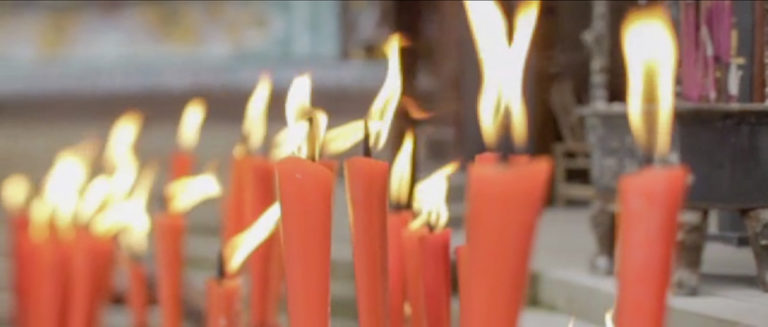On the day of the earthquake in Sichuan Province, Charlie, Ramone and John met at the Shamrock Bar and Grill in Chengdu at 7am and left on motorbikes for a tour of Qing Cheng Mountain.
Qing Cheng mountain is one of the most famous Daoist sites in China, covered in temples, pagodas and tea houses. It is about an hour northwest of Chengdu, right outside of Dujiangyan, an area hit hard by the earthquake.
It was a beautiful day for a bike ride. The sun was shining and there was a slight breeze. The ride up to Qing Cheng Mountain is lined with bamboo-covered hills and small brooks.

The three friends reached the top of the mountain just after noon and spent a couple hours taking pictures and touring the area. They decided to head down right around three o’clock. They paused for a moment on the way down, parking their bikes and stretching, when the earthquake hit.
“It was like an explosion. The houses started breaking apart all around us, the ground was shaking and glass was flying everywhere,” said Charles.
They got on their bikes and tried to navigate down the rolling mountainside, Charles was in front and was brought to a screeching halt when a landslide took out the road fifty feet in fron of him. His friends stopped behind him, and they turned around and headed back up the mountain. They hadn’t gone five city blocks when they came to a house that had collapsed into the street, blocking the way up.
“It was surreal. We were trapped and all of the buildings around us were crumbling into dust. The white powder covered everyone’s face, people came out into the road screaming and crying. There were many injuries – broken limbs, head trauma. It looked like Ground Zero after 911.”
By now, massive boulders and chunks of the old Daoist mountain were tumbling down into the small gorge next to the road. They were far away from where the friends were trapped, but they could hear them.
“The mountain blew up right in front of us. There were tremors every few mintues. I will never forget the thunderous echo of those boulders – as big as two-story buildings – crashing down the mountain and into the gorge. We saw a small bridge that crossed the gorge and led to a small hotel with a tennis court. We mustered up the balls to cross it and made our way into the tennis court.”

The earthquake subsided after five or so large tremors and the friends were safe on the far side of the river in the open tennis court. People wandered around in a daze, silent and staring up at the mountain.
“We used a ping pong table to build a small camp on the tennis courts and people started wandering over. In every building people had died. There were infants and old people; people trapped in the rubble. Everyone formed groups and tried to enter the buildings to rescue their friends and family, but it was still too dangerous. The tremors still shook the area, boulders fell from the mountain and buildings were still crumbling.”
Ramone and John took a headcount of all the people – 105 – and collected supplies. They found 300kg of rice, propane gas and some umbrellas. The camp was in a precarious position. The tremors kept coming, the mountains was falling apart and the sun was going down. As night fell, Ramone, Charlie and John huddled up with the locals and tried to get some sleep.
“It started raining hard when night fell and it was impossible to stay dry. We could hear the boulders falling and felt every tremor. I learned to distinguish the boulders by their sound: the little ones felt like rushing water and the big ones like thunder and explosions. The tremors always began small and rapid, then grew violent before subsiding again.”
They planned to leave at sunrise, but as dawn fell across the small gorge they were trapped in, the whole group stood and simply waited for something to happen. Then a tremor hit and a giant piece of the mountain came crashing into the gorge. Everybody panicked. The group rushed up the near side of the mountain, pulling themselves up through the mud and brush. The very old and the very young raced up and away from the mountain shattering across the gorge.
When they reached the top, they found a path that led to a tea house with chairs and a wooden shelter. The group gathered under the shelter and started a fire, cooking up rice porridge for breakfast/
“All of a sudden, a leader emerged. A man stood up on one of the benches and started yelling at the crowd. I couldn’t understand much, because the dialect is very thick. But from what I gathered, he said: I know the way, I can lead you out, who is with me? The whole crowd yelled “Hao!” (Yes!) and we set out.”

The man led the group down a clear path, then veered back down toward the river. The mountainside was muddy and denuded of trees, so it was very slow going. They were closer to the area where the boulders were falling and the raging river was right below. Them. It was long, tense hour before they managed to get all of the people across the muddy mountain and down to the road. The road was almost completely destroyed. Pieces had fallen into the river, boulders and landslides blocked the path. The group picked up pace and headed down the mountain.
“He led us through the damaged road, past total devastation. The small town on the shoulder of the mountain completely destroyed. I restaurant I had eaten lunch at thirty minutes before the quake it was gone, complete wreckage. Temples were destroyed, temples knocked over. It was like an abandoned war-zone with buildings half-exposed, but almost no other people. The whole town was flipped upside down.”
The followed the road down, often reaching parts virtually wiped out, leaving only one small path for the group to follow. When the group reached the ticketing office of the Qing Cheng Mountain Tourism Area, they joined about 500 people waiting in line. Local and military police organized everybody into two lines and guided them down the mountain. The roads and all paths were demolished. Everyone had to hang onto branches and bamboo and climb down a precarious, muddy path. Ramone and Charlie carried an old woman with head trauma along a path that hugged the cliff. She was in heels and ankle deep in mud. It was still raining and the tremors kept up throughout the day.

The road resumed farther down the path. Police and motorcycles started appearing on the road and the survivors stumbled past another destroyed village. When they reached the foot of the mountain, hundreds of people were milling about with their belongings in plastic bags, looking for transportation out of Qing Cheng Mountain. This is where the three friends split from the group.
“We found a car, but he did not have enough gas to get back to Chengdu and nobody was selling any gas, so we decided to go to Dujiangyan. We had no clue about the earthquake – where it was centered, how the rest of Sichuan had been affect or anything. We were shocked when we reached Dujiangyan. The city was in total chaos. Hundreds of thousands of people crowded the streets and military units were marching in formation carrying shovels – they were on the scene very quickly. Military and police vehicles flashed their lights and every open space in the city was covered in a tent. The buildings were not all totally demolished, but every building had sustained extensive damage. The bus station was closed and there were people everywhere with bags waiting to leave.”
They found a car back to Chengdu and listened to the radio on the hour-long drive back, learnkng of the extent of the damage done by the earthquake.
A few hours later, Charlie sits in the Sultan Restaurant in south Chengdu and shakes his head at the experience. He pulls out an ace of diamonds and shows it to me.
“This helped me get through, man. It was the only happiness I felt during that night. It was cold and wet and terrifying, but when I found that pack of cards I just felt a surge of happiness. I told everybody: Hey look, a deck of cards, we can really use this.”
He shakes his head and laughs.







7 thoughts on “Charlie’s Story: Surviving the Sichuan Earthquake”
How badly were the monastery and the temples damaged? A friend of mine is supposed to be there in about a month.
Thank you so much for posting this. I have been wondering what has become of the Temple on QingCheng Shan. I was there last year for two weeks on a Daoist retreat. Please do either post more information if you have it regarding the main temple and the smaller temples around the mountain. Or, please contact me directly at christina@therisinglotus.com.
Many blessings,
Christina
Feel free to email to ziggytheplatypus.hotmail.com
Beautiful post, man. Some of my comrades at Lonely Planet have been asking what’s going on in your neck, pointed ’em to Chachin for updates.
Stay shaken but not stirred!
Thanks for the information. Very hard to get any fron Qingcheng Shan after this terrible event. I lived down by the Big Gate, the main entrance to the area, for three years and am very concerned about the locals and the state of Qingyou Jie and thereabouts. Can you tell me about Neusoft Institute of Technology just down the road, and how the students and teachers coped with this quake? I have had no response from my friends in this area and are deeply concerned about them.
I have a good friend who works for Neusoft. Luckily she escaped, physically unscathed. She sent me a few pictures of buildings in the area. The damage is serious, but from what I saw most buildings didn’t totally collapse.
Thanks Jessie. Would it be possible for you to send me the pics at g_richardson10361@hotmail.com
I have heard from some Chinese teaching staff and a couple of students and i believe everyone is ok with just minor damage to the school. Luckily it is relatively new and constructed well. Thanks again.